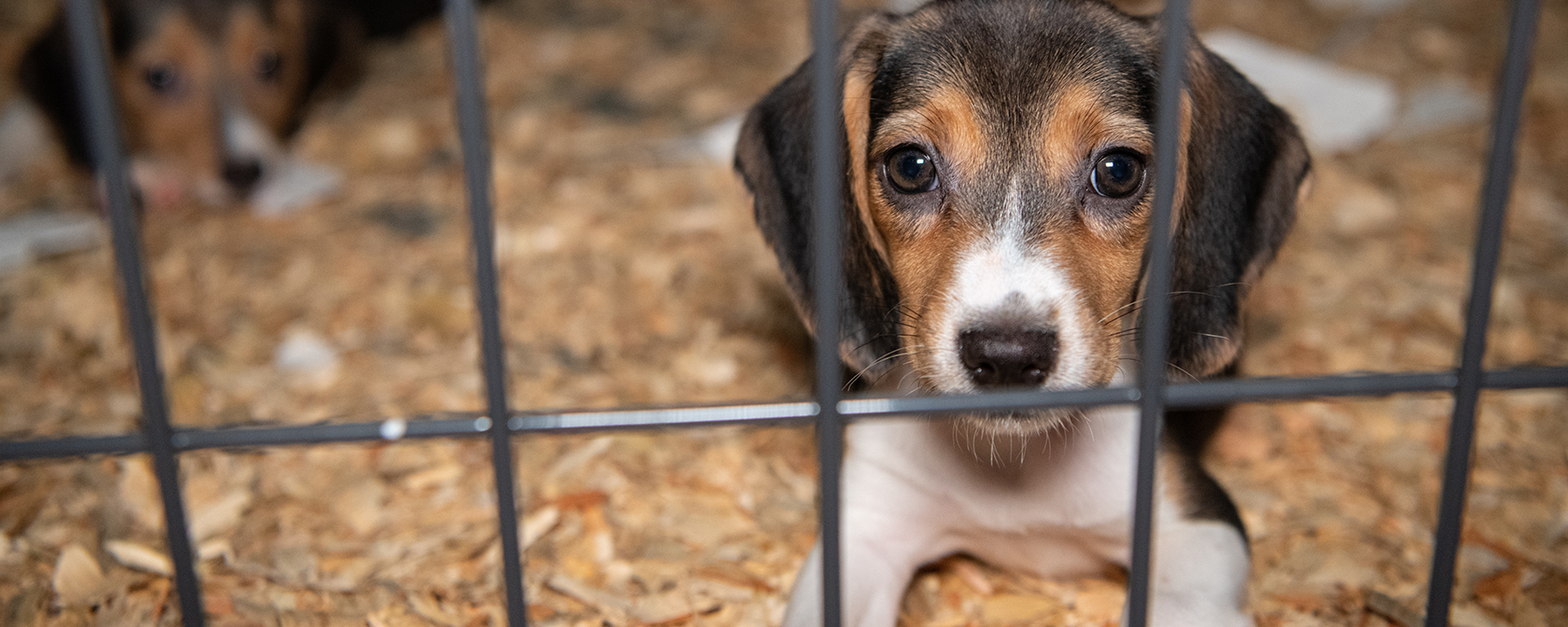By Sara Amundson and Kitty Block
The flood of inspection reports detailing animal neglect and suffering at puppy mills, wild animal attractions and animal laboratories in the U.S. regulated under the federal Animal Welfare Act continues to be overwhelming. Strengthening the ability of the U.S. Department of Justice to intervene in cases involving welfare violations would do a world of good for animals.
We are committed to the idea that real change for animals on a massive scale is possible. That’s why we are strong backers of the Better Collaboration, Accountability, and Regulatory Enforcement (CARE) for Animals Act, which was introduced as a bipartisan, bicameral bill in July 2023. Through our investigations, our detailed analysis of inspection reports, and our direct experience with government agencies charged with enforcement of the Animal Welfare Act, we know that the U.S. can and must do better in its efforts to do right by animals whose use and treatment in various institutions and businesses are regulated under federal law.
The Better CARE for Animals Act is one of the best animal welfare bills introduced in recent years, and the case for its passage is both just and urgent. Many lawmakers agree: The bill has 215 co-sponsors in the House and 34 in the Senate.
One of the most historic and notable cases that shows the power of cross-agency collaboration in taking a stand for animals is the case of the more than 4,000 beagles bred for experimentation, which made headlines in 2022. These dogs’ fates changed because of a federal prosecution of a breeding facility, Envigo, where, among other violations, government inspectors found that beagles there were being killed instead of receiving veterinary treatment for easily treated conditions. As the Envigo case and several others have made clear, stronger and more fluid cooperation involving the U.S. Department of Justice and the U.S. Department of Agriculture can spare animals from suffering. Based on the record, there’s every justification for granting the DOJ enforcement authority commensurate with that of the USDA, as well as the ability to seize and remove animals suffering mistreatment at substandard institutions. That’s the sum and substance of the Better CARE for Animals Act.
Help animals in roadside zoos, puppy mills and laboratories >>
We don’t have to probe too deeply to find compelling examples of what is currently wrong with the enforcement of the Animal Welfare Act. Some facilities violate welfare standards over and over again before any meaningful action is taken to prevent animals from suffering:
Animal laboratories: At animal testing facilities, low standards of animal welfare and care remain all too common. At the Oregon Health and Science University, for example, inspection reports have recorded noncompliant items every year for nearly a decade, with a total of 32 violations. The violations include multiple instances of animals—including monkeys—dying or being injured and animals receiving improper care due to inadequate veterinary treatment or observation. Many of these citations were considered critical (those with a serious adverse effect on animal health and well-being), including direct welfare violations involving animals’ health and the use of dirty, unsterile equipment.
Puppy mills: We’ve featured a puppy mill, Rocky Top K-9s in Missouri, in our Horrible Hundred report nine times. It has been the site of repeated violations involving extremely thin nursing dogs and puppies underweight and sickly. Even after an official warning in 2024, inspectors found more violations. Between October 2023 and May 2024, USDA inspectors visited the problem facility five times and found violations during four visits. Animals should not have to suffer for years before action is taken to better their quality of life. Currently in cases involving violations of the Animal Welfare Act, the DOJ can ask courts to issue injunctions to prevent continued unlawful mistreatment of animals, but the Better CARE for Animals Act would authorize the agency to use forfeiture to seize and remove animals experiencing harmful treatment. The agency could also seek license revocations and civil penalties.
Wild animal exhibits: As for captive exotic display and entertainment facilities, the case is bad enough on animal welfare grounds, but even worse when it comes to public endangerment. At Barn Hill Preserve in Louisiana, over the last 10 years the USDA has issued 29 citations (including 10 that were repeat, and five that were critical) and issued a $5,200 fine in 2023. Recorded incidents included an 8-month-old Asian small-clawed otter who died from injuries when an employee dropped a large metal tub filled with water on the animal; several bite incidents involving visitors participating in a swim-with-otter encounter; and a sloth who died from diarrhea after three weeks with no veterinary care. This sort of neglect should not be permitted to continue.
These are just a handful of places where the bar for animal welfare is set so low as to make a mockery of current federal law and enforcement activity. But they stand in for thousands of institutions and entities that shouldn’t be permitted to violate animals’ most basic needs, day after day, without more engagement from the regulatory authorities. We shouldn’t accept a status quo in which such places are permitted to operate, without serious penalty or repercussions, even though they are guilty of the same recurring offenses. By working together, the USDA and the DOJ can improve the situation for animals in such institutions by making it clear that enforcing animal welfare standards has become a priority in our society. All we need now is for the House and Senate to pass the Better CARE for Animals Act. You can show your support for this legislation. It would put us all on a better path to meeting our basic responsibilities to animals who are entirely at our mercy and who deserve the greatest measure of protection possible.
Kitty Block is CEO of the Humane Society of the United States.




